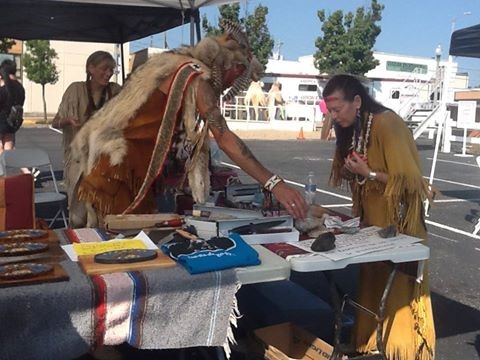These are a few of the traits that our Southern Cherokee ancestors possessed. Ours is a rich heritage filled with heroic figures and selfless leaders who always put the needs of their people before their own. We come from a free thinking people – individuals who had vision beyond the present. They could reason beyond emotion and were willing to sacrifice themselves for the future good of our people. We strive to live up to their standards and to emulate those characteristics in our daily lives.
Our story begins in the southern Appalachian Mountains around 8000 BC. We were once among one of the largest and most powerful Indian confederacies. Ancestors occupied around 140,000 square miles in what became parts of North and South Carolina, Tennessee, Alabama and Georgia. We were the first Federally Recognized Band of the Cherokee Nation (Treaty Party). We were the first of the Cherokee to take a stand against the loss of our lands to the immigrating Europeans; and the last to cease fighting in defense of our lands at the close of the Civil War.
We attempted to protect ourselves, first, through compromise, then through force and, finally, through the courts. When those failed to work, we attempted to assimilate and to adopt the ways of the white citizens. We hoped our progressive ways and willingness to adopt their agricultural practices would be viewed positively. It turns out that was not the answer either. We became quite successful. The result was: we began to be viewed as competition. Thus, our redolent lands became even more attractive, especially with the discovery of gold in our Georgia land holdings.
We finally had to accept the reality of the situation: the only answer for the survival of our people was to move west of the Mississippi, to Oklahoma. This is what the majority of the white land holders wanted. And President Andrew Jackson mirrored those desires. Our decision caused a deadly schism between those of us who chose to move west (followers of Major Ridge) and the other Cherokee (followers of John Ross), whose heartfelt wish was to remain where they were and hope for the best. By making our painful decision, we avoided the subsequent Trail of Tears, which cost the lives of some 4000 of our former brethren.
We soon found we weren’t safe in Oklahoma either. Once the survivors of the Trail of Tears arrived, it was demanded that we subject ourselves to Ross’s authority. To lose the identity we had fought so hard to attain was unthinkable. We could either face certain death or migrate back to a land where some of our ancestors had found solace; an isolated area abundant with game and heavily wooded so we would be protected.
That refuge was southern Missouri. Many Southern Cherokee had settled there earlier, in Phelps County, Missouri and surrounding areas. Unfortunately, we arrived at a complicated point in Missouri’s history. We found we had traded one dangerous situation for another. Indians were not welcome here at that time. We chose to remain here, however because the support system offered by our people was invaluable, and we were denied entry back into the lands of Oklahoma because of the genocide perpetrated against us. It is also characteristic of the Southern Cherokee, in helping one another through those crises, just as we do, to this day.
The Southern Cherokee operate in a circular, holistic realm. Whatever an individual thinks, speaks or does impacts seven generations in front of him or her. This omnipresent spiritual directive helps guide each citizen of the tribe to perform in a manner that not only supports and protects tribal citizens of this generation, but for many generations to come. We attempt to focus on the good things and learn what we might from the less positive experiences.
And we are focusing on good things. Since 1975, we have been free to emerge from the forests and take our places within society. We are progressing, learning, and growing. We are now free to have our gatherings in public. We may now tell people who we are with no fear of retribution. Our children can be, and are, proud of their Southern Cherokee heritage. Lastly, we are petitioning the Bureau of Indian Affairs for federal re-recognition in order to take our place within the diverse tapestry of the Native American community.
We dedicate this website to the citizens of the Southern Cherokee Indian Tribe in an effort to share our complicated history and revel in the many accomplishments. Our history is wrought with many successes and an equal amount of disappointments. We wish to ignore neither. Both have contributed to who we are today. If you have visited other websites regarding the Southern Cherokee, you will be very confused. And for that we are profoundly sorry. You will see a variety of those websites claiming to represent the “true” or “official” Southern Cherokee.
To make matters more confusing, you will see some of the same facts authenticating those claims at each website – including ours: Treaty Party, Treaty of 1835, Treaty of 1846, and Treaty of 1866… plus other numerous historical references. These are key events in Southern Cherokee History. They are facts that separate us from other tribal groups and mark significant events in our history.
How, then, can you know which site/group is authentic? Unfortunately, there is only one way. You’ll need to explore each website and make your own determination. We thank you for exploring our website and for taking interest in the Southern Cherokee. Ours is a complicated and fascinating history and we are proud to share it with you.
[Until we meet again.]
